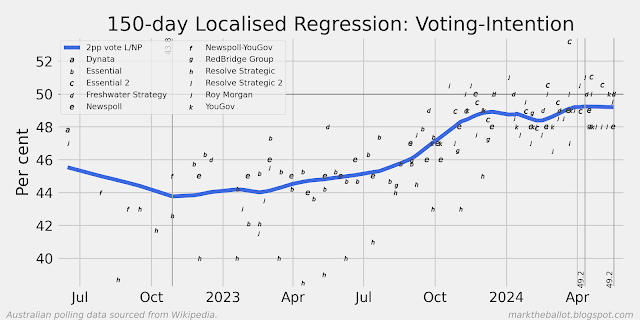Turning to the Bayesian polling aggregations, we see a similar picture (albeit a touch more favourable to Labor). The Bayesian analysis considers the tendency for each polling firm's methodology to favour one party or another. The model assumes that collectively the polls are unbiased, even if an individual polling firm may have an unintended bias.
Please note, I am treating the Resolve Strategic polls from this year as a different series from its earlier polls. I do this when a polling firm indicates that they have changed their methodology, or it looks like a firm may have changed its methodology. In this case, it is because it looks like Resolve Strategic may have changed.
Also note, the charts marked with GRW are based on a Gaussian Random Walk, where the population voting intention on one day is assumed to be much like the voting intention on the previous day. The charts marked with GP are based on a Gaussian Process, where polls taken closer together are assumed to be more correlated than polls taken further apart in time. The GP approach to poll aggregation is (for me at least) a little experimental. It has a tendency to revert to a base state when polling frequency is low, and at each end of the series. I have set the base state to the average of the last 10 or so polls, but this does affect the early part of the series where polling was less frequent.
Finally, a quick update from Sportsbet, which I seek to monitor on a daily basis. Little has changed in the past month in respect of how the betting market sees the outcome of the next election. (Note: the specific question is which party will provide the Prime Minister following the next election.)






















No comments:
Post a Comment